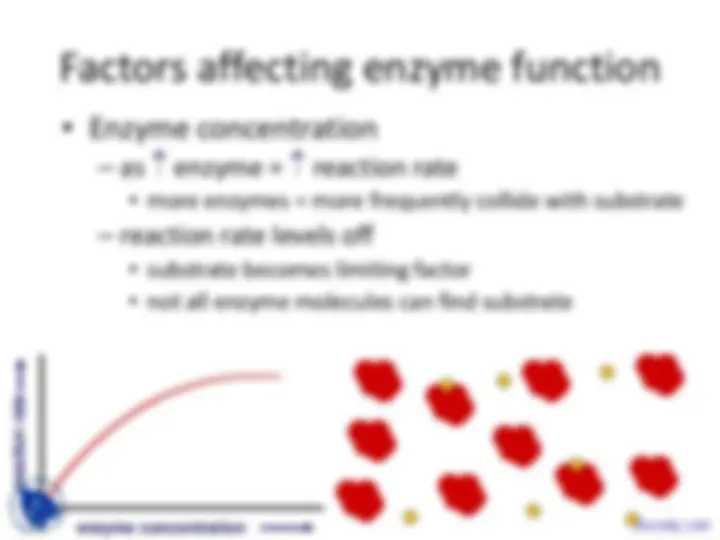Download Metabolism and Enzymes: Understanding the Flow of Energy in Living Organisms and more Slides Biology in PDF only on Docsity!
Metabolism & Enzymes
From food webs to the life of a cell
energy
energy
energy
Metabolism
• Chemical reactions of life
- forming bonds between molecules
- dehydration synthesis
- synthesis
- anabolic reactions
- breaking bonds between molecules
- hydrolysis
- digestion
- catabolic reactions That’s why they’re called anabolic steroids!
Examples
dehydration synthesis (synthesis)
hydrolysis (digestion)
H 2 O
H 2 O
enzyme
enzyme
Chemical reactions & energy
• Some chemical reactions release energy
- exergonic
- digesting polymers
- hydrolysis = catabolism
• Some chemical reactions require
input of energy
- endergonic
- building polymers
- dehydration synthesis = anabolism
digesting molecules= LESS organization= lower energy state
building molecules= MORE organization= higher energy state
Endergonic vs. exergonic reactions
exergonic endergonic
**- energy released
- digestion**
- energy invested
- synthesis
- ∆ G
∆ G = change in free energy = ability to do work
+ ∆ G
What drives reactions?
• If reactions are “downhill”, why don’t they just
happen spontaneously?
- because covalent bonds are stable bonds Why don’t stable polymers spontaneously digest into their monomers?
starch
Activation energy
• Breaking down large molecules requires
an initial input of energy
– activation energy
– large biomolecules are stable
– must absorb energy to break bonds
cellulose (^) energy CO2 + H 2 O + heat
Reducing Activation energy
• Catalysts
- reducing the amount of energy to start a reaction Pheeew… that takes a lot less energy!
reactant
product
uncatalyzed reaction
catalyzed reaction
NEW activation energy
Catalysts
• So what’s a cell got to do to reduce
activation energy?
– get help! … chemical help… ENZYMES
∆ G
Call in the ENZYMES!
Enzymes vocabulary
substrate
- reactant which binds to enzyme
- enzyme-substrate complex: temporary association
product
active site
- enzyme’s catalytic site; substrate fits into active site
substrate
enzyme
products
active site
Properties of enzymes
• Reaction specific
- each enzyme works with a specific substrate
- chemical fit between active site & substrate
• Not consumed in reaction
- single enzyme molecule can catalyze thousands or more reactions per second - enzymes unaffected by the reaction
• Affected by cellular conditions
- any condition that affects protein structure
- temperature, pH, salinity
Lock and Key model
- Simplistic model of enzyme
action
- substrate fits into 3-D structure of enzyme’ active site - H bonds between substrate & enzyme
- like “key fits into lock”
In biology… Size doesn’t matter… Shape matters!
Induced fit model
• More accurate model of enzyme action
- 3-D structure of enzyme fits substrate
- substrate binding cause enzyme to change shape leading to a tighter fit - “conformational change” - bring chemical groups in position to catalyze reaction






















































































